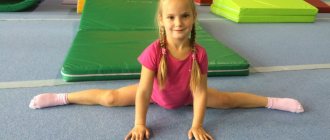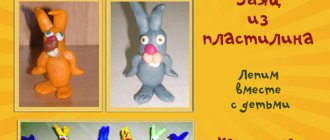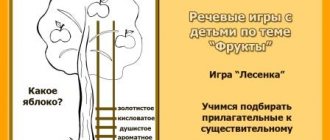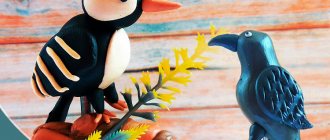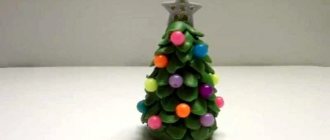Modeling fruits from plasticine
Another master class on plasticine modeling from our regular author Elena Nikolaeva.
Girls can feed their dolls not only with healthy vegetables, but also fruits , which are also worth learning how to sculpt from plasticine. Two parallel modeling classes will help children quickly navigate and distinguish vegetables from fruits. Of course, the list of such fruits is inexhaustible, so we will learn how to sculpt only a few (the most popular options).
sculpting fruits to coincide with the harvest festival, if we are talking about rural areas, or with the autumn school exhibition of crafts. This could be a standard labor lesson in elementary school or a training session in kindergarten. Even the youngest children can easily find objects to copy among the fruits, choose the appropriate color of plasticine from the box and create a craft, remembering what the object looks like.
In this sculpting lesson we will learn how to sculpt an apple, pear, plum, orange and grape. And then all that remains is to feed your dolls with foods rich in vitamins. For work you will only need blocks of plasticine and stack (photo 1).
How to make an apple from plasticine
To sculpt an appetizing apple, choose green (dark or light), yellow or red. Green may also be needed to form a leaf (photo 2).
The shape of an apple is a ball. Roll it out of red plasticine or another color. To make the fruit more colorful, you can add green or yellow barrels. In this case, prepare a small piece of green plasticine (photo 3).
Make a cake from green plasticine and attach it to the red fruit (photo 4).
Crush the green plasticine with your fingers, smoothing the surface of the ball. Roll the dough again in your hands to get a unique fruit (photo 5).
Make a hole (recess) on one side with the tip of the stack (photo 6).
Insert a brown stalk into the hole and attach a green leaf to make it clear that this is a ripe and appetizing apple (photo 7).
How to make a pear from plasticine
When sculpting a pear, we will not stop at one color, but will mix several suitable shades at once: red, yellow, orange, green and their various shades. Prepare several suitable pieces (photo 8).
Pull all the pieces into sausages (photo 9).
Intertwine and mix the sausages together to get an unusual multi-colored mass (photo 10).
Create a pear by shaping the soft mass into the correct shape, like a light bulb (Photo 11).
Also add a cutting and a leaf, after making a recess (photo 12).
How to make plums from plasticine
To sculpt plums, you can use lilac, purple, blue, green, yellow and other colors of plasticine. Choose any of them and knead (photo 13).
Make several small balls (photo 14).
Draw out the balls into oval pieces. Using a stack or toothpick, apply a longitudinal stripe to each fruit. Prepare very thin gray threads as cuttings (Photo 15).
Make several plums (photo 16). Cherry plums are also made in the same way, only the shape of the parts is better left round, apricots - to make them you will need orange plasticine.
How to make an orange from plasticine
Modeling an orange will not cause any difficulties for anyone. Initially, you should roll an orange ball (photo 17).
Place a small brown dot on the ball. Using a stack or toothpick, start making holes all over the surface of the ball (Photo 18).
Smear the entire surface to obtain a fruit with a thick, rough skin (Photo 19). The same method can be used to make tangerines, only the balls will have to be flattened a little during sculpting.
How to make grapes from plasticine
To sculpt a bunch of grapes, you will need two types of plasticine: for leaves and tendrils, and for berries. For example, it could be green and purple plasticine (photo 20).
Roll purple balls (Pic 21).
Make the balls more oblong. Attach them together to form a bunch of grapes (photo 22).
Pull the green plasticine into very thin strands to create antennae. And also prepare round cakes, from which cut out grape leaves in a stack (they are similar in shape to maple leaves) (photo 23).
Glue the stem, leaves, and tendrils to the brush to get very tasty and healthy food for dolls (photo 24).
Our set of fruits is ready (photo 25).
All together they look like real autumn wealth. And after work, the girls will be able to continue playing with their dolls and feed them.
See here for information on modeling vegetables from plasticine.
In order not to forget the address of the page and share with friends, add it to your social networks: Do you want to know news about competitions or master classes?
Tags: Food for dolls, Modeling
Attention! It is better to write urgent questions in the comments on the website (form at the bottom of the page) or, better yet, directly by email. There are no notifications about comments from the VKontakte form! This form is more for feedback. 
Your comment Cancel reply
Application with plasticine
Children at two years old do not yet know how to hold scissors and brushes in their hands. But their children's hands easily roll plasticine balls. Exciting activities to make colorful fruits bring joy to the process.
After all, beautiful stucco pictures are created right before your eyes. Such crafts last a long time, so they are suitable for decorating play corners.
Stores sell applique kits at prices starting from 58 rubles. The set for the little ones includes four pictures with fruits, multi-colored plasticine, and stacks.
As a backup option, you can use: thick cardboard, disposable plastic plates, yogurt or sour cream lids. Using a felt-tip pen, draw the outlines of fruits familiar to children. The following actions accompany the display:
- Small pieces are plucked from plasticine.
- Roll balls and stick them to the base.
In older preschool age, coloring books are often used for creativity. Silhouettes are cut out from the book and glued onto cardboard. Then they roll the balls and stick them to the outline pictures. Children are also taught to use several colors of plasticine in one craft.
Fruits in quilling style
Twisting narrow strips into spirals is a labor-intensive process, but understandable to older preschoolers. Fruit slices are made using the quilling technique.
Materials that will be useful for creativity: colored paper, disposable cardboard plate, glue. Tools: pencil, ruler, scissors, toothpick.
How to make kiwi slices
For 1 slice, cut 8 green strips 0.5 cm wide and 30 cm long:
- Alternately twist onto a toothpick with a spiral.
- They are formed into drops by squeezing one part of each shape with your fingers.
The center of the kiwi is made from a white strip of the same width and length. A tight roll is made from it, loosened slightly, and then flattened with the palm of your hand.
Last step: 4 brown strips are glued together with one long strip. A ring is made from it, which is glued to the base. Inside, fix a white center in the center, and green drops around them, placing them in a circle.
How to make orange slices
Cut strips of white, yellow and orange paper:
- Combine the yellow and white stripes into one.
- Screw onto a toothpick, starting from the yellow end.
- Form a triangle - squeeze the spiral in three places with your fingers.
- Glue the blanks together to form an orange slice.
Three orange stripes are combined into one strip and pasted around the triangular blanks.
Looking through photos of children's crafts, you might think that stunning still lifes are created by young talents.
Paper fruits made using different techniques are simply impressive in appearance.
I want to decorate the walls of my apartment with appliqués and decorate the New Year tree. And also give as a gift to relatives and friends from the whole family.
Circle applique
The first paper products that even three-year-old children can make are fruit appliques from multi-colored circles. Riddles, songs, counting rhymes, sayings and proverbs on the topic will help to interest the kids.
Creative activity will not be boring if you make a note that reflects what goals you need to achieve:
- Talk about the benefits of the fruit.
- Learn how to glue round shapes using glue.
- Fix shapes and colors.
- Instill neatness.
Preschoolers do not yet master concepts and think only in visible, concrete images. Therefore, for practicing applique, visual material is prepared: apples of three colors of different sizes on a plate. Adults also cut out blanks from paper:
- A white circle with a radius of 20 cm is for the base.
- Yellow, red and green circles are for fruits.
With children, they look at each apple on the plate, analyze the sizes and differences. They offer to capture them by accurately laying out colored circles on the base.
Then they begin the practical part: they are introduced to the simple technique of paper appliqué. They show how to smear parts and press them onto paper using a napkin.
